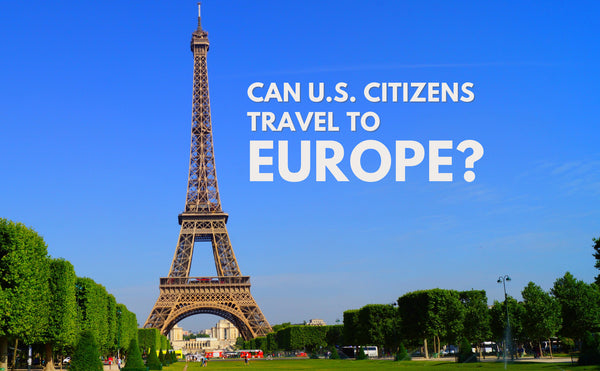Europe’s Travel Restrictions for U. S. Citizens
Can Americans Travel To Europe?
This post may have affiliate links, which means we may receive a small commission (at no extra cost to you!) if you choose to purchase through them. Here’s our Disclosure & Privacy Policy for more info.
Share The Article
Last Updated 2 years ago
While U.S. travelers have been locked out of many parts of Europe for months, there have been select countries allowing Americans to visit. If you’re wondering if tourists from the United States can travel to Europe, you’re definitely not alone.
Different travel restrictions for the EU, Schengen and the UK make traveling overseas seem like you need a University Degree in immigration just to understand the rules.
At Travel Off Path, we are going to make heading to Europe a whole lot easier for you. Without the fluff and all the fancy words we’re going to let you know which countries actually allow U.S. travelers and what you’ll need to do to enter to the select few countries in Europe that are accepting American tourists.

First things first, Europe is huge and has different zones, memberships, unions and lots of things to confuse everyone. When we say Europe we mean ALL of it.
If the European country you’re looking for isn’t listed below, it’s not open to American travelers.
At the bottom we include a bonus European country for the savvy traveler.

Can Americans Travel To Europe?
While the majority of Europe is closed to U.S. travelers because the travel ban for US residents entering the European Union is still in effect, there are select European countries are accepting American tourists.
Below are all the countries in Europe that are open for American travelers.
Albania

Americans can currently travel to Albania in Southeast Europe without any restrictions.
There are no testing requirements or quarantines upon arrival.
Armenia

Armenia is located in the mountainous Caucasus region between Asia and Europe and is open to American travelers.
Travelers will have to quarantine for 14 days unless they order the mobile PCR testing which can release them from quarantine by day 4.
Belarus

Americans can travel to Belarus which is a small landlocked nation in Eastern Europe.
There are no quarantines and a PCR test is recommended.
Bosnia and Herzegovina

Bosnia and Herzegovina is a country on the Balkan Peninsula in southeastern Europe and is currently accepting United States Travelers.
All passengers must bring a negative PCR test no older than 48 hours prior to departure.
Croatia

The only member of the European Union on the list is Croatia! Americans can travel to Croatia which is a country at the crossroads of Central and Southeast Europe on the Adriatic Sea.
American travelers must present a negative COVID-19 test and fill out an online form before traveling to Croatia.
Kosovo

Kosovo, officially the Republic of Kosovo is located in Southeastern Europe and currently open to American tourists.
Montenegro

Americans can travel to Montenegro which is a Balkan country in Southeastern Europe.
Montenegro lifted the quarantine restriction American travelers and is only requiring a 72 hour PCR test.
North Macedonia

Americans can travel to North Macedonia which is a Balkan country in Southeastern Europe.
There are no testing or quarantine requirements for American tourists.
Serbia

Americans can travel to Serbia which is an European nation that borders Montenegro, Hungary, Bulgaria and Romania.
Serbia has no testing or quarantine requirements for American travelers.
Turkey

A small portion of Turkey (3%) is located in the Balkan Peninsula and is still considered Southeast Europe and is open to United States citizens.
There are no mandatory testing or quarantines for American travelers visiting Turkey.
United Kingdom

While the UK is not encouraging tourism, travelers from the United States can travel to the United Kingdom.
All U.S. travelers will face a mandatory 14 day quarantine upon arrival.
Ukraine

Americans can travel to the Ukraine which is situated in the central part of Eastern Europe.
US residents will have to bring a negative PCR test no older than 48 hours to bypass strict entry requirements.
BONUS

For American expert travelers looking to travel to Italy there may be a way to get there if you have extra time and patience.
“Can I Enter ‘x’ EU/Schengen Country After Spending 14-days in Croatia or the UK?”
We get asked this question daily. The answer is = maybe
Currently, there is a travel ban for residents of the USA into countries that belong to the European Union.
SOME EU nations (like Italy and Malta for example) have been very transparent that US residents may enter, as long as they have spent the last 14-days in a ‘safe’ nation, like Croatia.
Most other EU nations will not publicly state if they will allow US residents in after they spend 14-days in a safe nation. Mostly because, they base their travel bans on ‘RESIDENCY + LOCATION’, meaning they want visitors to be a RESIDENT of a safe country, and currently LOCATED for the past 14 days in a safe country.
If you are a US resident and you want to enter EU nations like Germany, Portugal, France, Spain, etc… you will need to contact the consulate and/or border police to find out if first spending 14-days in a safe nation will then allow you to enter.
Europe’s Travel Restrictions for U.S. Citizens

Countries across Europe have now lifted COVID-19 entry requirements for travelers from America and other third countries.
Nationals that have removed COVID-19 restrictions for Americans include Austria, France, Italy, and Portugal. Vaccinated and unvaccinated U.S. citizens can visit these European destinations.
A vaccination certificate or PCR tests for travelers from the U.S.. may still be required by some EU nations.
European Coronavirus Travel Restrictions for U.S. Visitors
The EU is recommending that fully vaccinated Americans should be allowed to enter the bloc.
Most member states now allow any traveler who has been fully vaccinated with an EU-approved COVID-19 vaccine to enter. Many are now allowing non-essential travel from the U.S. regardless of vaccination status.
Each EU member country is free to decide whether to allow entry to travelers from outside the bloc. However, many member states will follow the EU’s advice regarding passengers arriving from the U.S.
American tourists need to check the entry requirements for each European country they will visit.
Are Americans banned from visiting Europe?
Americans are not banned from entering Europe. U.S. citizens who meet the standard entry requirements and any remaining COVID-19 requirements can travel to Europe.
Any EU country that implements this travel restriction for travelers from the U.S. will still allow entry to the following Americans:
- Fully vaccinated travelers
- Americans arriving from a “safe” country (providing they have not been in a high-risk country recently)
- Americans traveling for urgent reasons
When Will Europe Lift Its Travel Restrictions for U.S. Tourists?
EU member states are responsible for setting their own entry rules. How quickly restrictions are eased will depend on the individual country.
Most European nations have already fully lifted entry restrictions for U.S. citizens, regardless of vaccination status.
Visitors must check the latest rules for the EU member state they wish to visit. Requirements and restrictions vary from country to country.
For the EU to add a country to the safe list, the nation’s epidemiological situation must have stats close to or below the average of EU coronavirus cases as of 2 weeks prior.
Furthermore, for countries to be on the approved EU entry list, they need to have credible data, including:
- A stable or decreasing trend of new cases
- Satisfactory COVID response: testing, surveillance, contact tracing, containment, treatment, and reporting
The EU safe list is revised and updated regularly. The United States is not currently included.
Where in Europe Can U.S. Tourists Travel?
U.S. tourists traveling to Europe can visit most parts of the EU and Schengen Area.
Several nations, including Austria, France, Italy, Latvia, and Portugal , have lifted all restrictions, including for travelers without a vaccine certificate. More countries are relaxing restrictions for unvaccinated visitors.
Travelers need to check the specific entry requirements for each nation.
Other exemptions to the EU travel ban
Entry restrictions in the EU are not only based on the departure country. Other exceptions to the EU travel ban include U.S. citizens with permanent resident status or long-term visa holders.
Furthermore, there are a number of traveler categories that are also exempt from European travel restrictions, including:
- Health care professionals
- Seasonal workers in agriculture
- Diplomats
- Passengers traveling for family reasons
- Transit passengers making a stopover in the EU en route to a third-country destination
Tourism in Europe during COVID-19
Tourism has now returned to European destinations. Americans can visit most countries with few additional restrictions.
Hotels and other accommodation are available and restaurants are operating as normal in most cases.
Tourist attractions are open and welcoming visitors.
Face masks may be required on public transport and other indoor public spaces. Tourists from the U.S. should check the latest rules before traveling to a European country.
ETIAS And Public Health in the EU
Beyond COVID-19, the European Union is taking other measures to ensure the public health of its visitors, residents, and nationals.
One of these initiatives is ETIAS U.S. or European Travel Information and Authorization System. U.S. citizens are amongst those eligible to obtain an ETIAS, planned to start from November 2023.
The application is online, where travelers will be required to fill out their information, including some health details. The health questions on the visa waiver application form are one way in which ETIAS will protect Americans’ public health.
Benjamin Murphy is a freelance travel writer from Ohio, specializing in the European Union’s myriad of options for travel. After moving to the UK, he began collaborating with various media outlets, covering travel advice and entry requirements in an ever-changing tourism industry.
Related Posts

Do Americans Need a Vaccine Certificate to Travel to Europe?
The European Union has a vaccination certificate scheme. Travelers with this electronic document are able to enter the different.

EU to Implement Digital Green Pass Vaccine Certificate
A Digital Green Pass will be implemented for traveling to Europe, Ursula von der Leyden, the President of the.

COVID-19 PCR Test to Travel to Europe from the U.S.
Many EU countries now require that travelers arriving from the U.S. and other third countries are tested for coronavirus.
Can US Citizens Travel to Europe? Here Is What You Need to Know before Making Travel Plans
The United States has been removed from the European Council’s approved countries list for entry, together with Israel, Kosovo, Lebanon, Montenegro and North Macedonia – leaving travellers with the question of whether Americans can travel to Europe or not, and whether they need to make any changes to their travel plans.
Following that, the countries in the EU and Schengen Area have responded to the recommendations and adjusted their own policies of who is eligible to enter. Some member states prohibit non-essential travelling purposes regardless of the vaccination status, some allow vaccinated travellers only, and some are open for both but with quarantine restrictions and COVID-19 testing requirements.

In this article from CabinZero, we will list out some examples of how some European countries have given out different restrictions for vaccinated and unvaccinated travellers arriving from the United States.
Are Americans still allowed to travel to Europe now?
Yes, but it depends on which country they are travelling to. Some countries are open to U.S. vaccinated travellers, some require an additional quarantine in place, some are closed for unvaccinated travellers, while some are entirely closed to U.S. citizens.
Why has the U.S. been removed from the European Council’s approved countries list?
There are certain epidemiological benchmarks of which countries can reach, they can be considered to be on the list of the European Council’s approved countries. Countries need to have no more than 75 new cases daily per 100,000 inhabitants in order to stay on the safe list. Unfortunately with the Delta variant wave, the U.S. has exceeded some of the benchmarks, therefore, it has been removed from the approved list.
What proof of vaccination do Americans need to enter Europe?
A paper vaccination certificate issued by CDC will be adequate as one of the entry requirements for American citizens who wish to enter a European country.
Where can Americans travel in Europe?
Austria
Vaccinated travellers are allowed to enter Austria with proof of vaccination (of an EMA-approved vaccine), no more than 270 days before arrival for one-dose vaccines or 360 days for two-dose vaccines and booster shots, or 180 days after testing positive for COVID-19.
Unvaccinated travellers must show proof of a negative test result (a PCR test taken within 72 hours before arrival or a rapid test within 48 hours before arrival), and will have to quarantine for 10 days.
Belgium
Vaccinated travellers are allowed to enter Belgium provided that they take a COVID-19 test upon arrival and quarantine until they receive the results. Travellers also need to fill in the Passenger Locator Form within 48 hours before arrival.
Unvaccinated travellers are currently not allowed to enter Belgium for non-essential travel purposes.
Bulgaria
Vaccinated travellers are not allowed to enter Bulgaria except for specific exceptional cases and proof of a valid negative pre-departure PCR test up to 72 hours before arrival.
Unvaccinated travellers are currently not allowed to enter Bulgaria.
Croatia
Vaccinated U.S. travellers are allowed to enter Croatia with proof of vaccination in the last 270 days or recovery from COVID-19.
Unvaccinated U.S. travellers are allowed to enter Croatia if they can show proof of a negative PCR test result no more than 72 hours before their arrival to Croatia.
Travellers with tourist reasons must show proof of booked accommodation for their stay upon arrival to Croatia.

Photo by Mich D on Unsplash
Cyprus
Vaccinated travellers are allowed to enter the island of Cyprus if they can provide proof of vaccination with an EU-approved vaccine, and also the Sputnik (Gam-COVID-Vac) or the Sinopharm (BBIBP COVID-19), or proof that they have had COVID-19 in the past 180 days. Passengers can upload these documents into the Cyprus Flight Pass up to 48 hours prior to arrival.
Unvaccinated travellers are allowed to enter Cyprus if they can provide a negative PCR test result taken no more than 72 hours before departure, and they will need to take another test upon arrival at their own expense.
The Czech Republic
Vaccinated travellers are allowed to enter the Czech Republic with proof of vaccination or recovery from COVID-19 in the past 180 days. They will also need to fill in the Passenger Locator Form before arrival.
Unvaccinated travellers are allowed but they must arrive with a negative PCR test, have to go through quarantine and take a PCR test not before day 5 of self-isolation.
Denmark
Vaccinated travellers with proof of vaccination of an EMA-approved vaccine or recovery from COVID-19 can enter Denmark without quarantine requirements.
Unvaccinated travellers are not allowed to enter Denmark for non-essential reasons. Unvaccinated visitors to Denmark for work or essential purposes must get tested upon arrival and enter quarantine. They can get out of quarantine with a negative test result on day four.
Estonia
Vaccinated travellers and people who have recovered from COVID-19 are allowed to enter Estonia. Unvaccinated travellers are currently not allowed.
Finland
Vaccinated travellers and people who have had COVID-19 are allowed to Finland. The vaccination certificates need to be in either English, Finnish or Swedish – translated certificates are allowed as well. They can also be an EU digital certificate.
Unvaccinated travellers are currently not allowed to enter Finland as follows this guide from the Finnish government.
France
Vaccinated travellers are allowed to enter France with proof of full vaccination. Children above the age of 12 must show a negative COVID-19 PCR test result.
Unvaccinated travellers are not allowed to enter France for non-essential travel reasons.

Photo by Soroush Karimi on Unsplash
Germany
Vaccinated travellers are allowed to enter Germany. They will have to fill in the Digital Registration On Entry before arrival.
Unvaccinated travellers are not allowed to enter Germany for non-essential purposes. If they intend to travel to Germany for work purposes, they can provide a negative COVID-19 PCR test result and must quarantine for ten days.
Greece
Vaccinated travellers are allowed to enter Greece without having to undergo any testing requirements.
Unvaccinated travellers are allowed to enter Greece with some requirements. They must provide a negative COVID-19 PCR test valid within 72 hours before departure, a negative RAT test result that has been taken no more than 48 hours before arrival, or they show proof of having had COVID-19 in the past 30-180 days. The Greek authorities are subject to conducting random testing for passengers arriving in Greece.
Hungary
Vaccinated travellers are allowed to enter Hungary with an EU Digital COVID certificate. If they can’t provide the certificate, they will have to show a negative PCR test result taken no more than 72 hours before arrival.
Unvaccinated travellers are allowed to enter Hungary if they can provide a negative PCR test result taken no more than 72 hours before arrival in an EU, OECD, NATO member state, or Russia, China, the UAE, Bahrain, or a Turkic council member state (Azerbaijan, Kazakhstan, Kyrgyzstan, Turkey, or Uzbekistan).
Iceland
Vaccinated travellers are allowed to enter Iceland with a negative test (it can be either PCR or rapid test) taken no more than 72 hours before departure. People who have recovered from COVID-19 who have their proof of a positive PCR test taken 14 to 180 days prior to the flight will not have to submit a negative test result upon boarding.
Unvaccinated travellers are allowed to enter Iceland with a negative PCR test result taken within 72 hours before departure, and they must go through a 5-day quarantine.
Ireland
Vaccinated travellers and people who have recovered from COVID-19 in the past 180 days are allowed to enter Ireland without any requirements.
Unvaccinated travellers are allowed to enter Ireland with a negative PCR test result taken no more than 72 hours before arrival, and must go through a 14-day quarantine period (they can ‘test out’ after day 5 with a negative test result).

Photo by K. Mitch Hodge on Unsplash
Italy
Vaccinated travellers are allowed to enter Italy with a negative COVID-19 test result taken no more than 72 hours before arrival (this can be either PCR or rapid test).
Unvaccinated travellers are allowed to enter Italy with a negative COVID-19 test result but they must go through a 5-day quarantine, even if the result is negative. They need to take another test on day 5 to leave quarantine.
Latvia
Vaccinated travellers are allowed to enter Latvia and unvaccinated travellers are not currently allowed to.
Lithuania
Vaccinated travellers are allowed to enter Lithuania if they have had one of the following vaccines: Comirnaty (Pfizer/BioNTech), Moderna, Janssen or Vaxzevria (AstraZeneca).
Unvaccinated travellers are allowed to enter Lithuania but they must show a negative PCR or antigen test result, and enter a 10-day quarantine. They can ‘test out’ on day 7.
All passengers must fill in a form within 48 hours before arrival.
Luxembourg
Either vaccinated or unvaccinated travellers from the U.S. are currently not allowed to enter Luxembourg.
Malta
Vaccinated travellers are allowed to enter Malta but unvaccinated ones are not.
The Netherlands
Vaccinated travellers are allowed to enter the Netherlands without the need to quarantine.
Unvaccinated travellers are not allowed to enter the Netherlands at the moment. However, if they have an essential reason to travel that falls under a specific category of circumstances of the EU , they need to undergo testing.
Norway
Either vaccinated or unvaccinated travellers from the U.S. are currently not allowed to enter Norway.
Poland
Vaccinated travellers from the U.S. are allowed to enter Poland without any quarantine requirements.
Unvaccinated travellers are allowed to enter Poland but they need to self-isolate for 10 days and they can ‘test out’ on day 7.
Portugal
Both vaccinated and unvaccinated travellers from the U.S. are allowed to enter Portugal. Passengers over 12 years of age should have an EU Digital Covid certificate or must show proof of a negative PCR COVID-19 test taken within 72 hours before departure, or a rapid test was taken within 48 hours.
All travellers from the U.S. must fill out a form , and if they get COVID-19 while in Portugal, they must enter a 10-day quarantine at their own expense.
Romania
Vaccinated travellers are allowed to enter Romania if they have been vaccinated at least 14 days before arrival or have had COVID-19 during the past 90 days, without the need to quarantine.
Unvaccinated travellers are allowed to enter Romania but they must self-isolate for 14 days, even with proof of a negative COVID-19 test result. They can ‘test out’ after day 10 if they test negative for COVID.
Slovakia
Vaccinated travellers coming to Slovakia for work purposes are allowed without quarantine. Otherwise, travelling for other reasons require quarantine.
Unvaccinated travellers are allowed to enter Slovakia but they have to quarantine for 14 days. They can ‘test out’ after day 8.
All passengers must fill in a registration form prior to arriving in Slovakia.
Slovenia
Vaccinated travellers are allowed to enter Slovenia with a negative COVID-19 test (either PCR or antigen test) taken within 72 hours prior to arrival. People who have recovered from COVID-19 are allowed if they have proof of COVID-19 no more than 90 days before arrival.
Unvaccinated travellers are not allowed to enter Slovenia except for business purposes and essential reasons.
All passengers must fill in a form prior to arrival.
Spain
Vaccinated travellers are allowed with a QR code on a Spanish portal .
Unvaccinated travellers from the U.S. are not allowed to enter Spain at the moment.

Photo by Henrique Ferreira on Unsplash
Switzerland
Vaccinated travellers from the US are allowed to enter Switzerland without further travel restrictions if they have received one of the following vaccines: Pfizer/BioNTech, Moderna, AstraZeneca, Janssen/Johnson & Johnson, Sinopharm/BIBP and Sinovac. People who have recovered from COVID-19 are also exempt from quarantine if they can provide proof that they have had the virus.
Unvaccinated travellers from the U.S. are not allowed to enter Switzerland for tourism purposes.
You can check this tool to see if you are eligible to enter Switzerland.
England
Vaccinated travellers are allowed to enter England without the need to quarantine but they need to undergo testing. The U.S. is now on the UK ‘amber list’, which means that passengers must show a negative COVID-19 test result and take another test on or before day 2 after arrival.
Unvaccinated travellers are allowed to enter England but they have to quarantine and undergo testing. They need to have a negative COVID-19 test result before departure and they will need to quarantine for 10 days upon the arrival. They will need to take a PCR test on day 2 and 8. They can ‘test out’ on day 5, but the costs could be expensive.
All passengers who arrive in the UK must fill in a Passenger Locator Form within 48 hours before arrival.
Europe Travel Advice For US Citizens
It is important to note that there are public health measures across all of Europe. There might be limited opening hours for some businesses, services, entertainment venues and tourist attraction sites. Some European countries have a curfew and other restrictions in place, including providing a COVID-19 pass to enter certain places. These mandatory restrictions are updated regularly so make sure you check them carefully before you make any travel arrangements.
U.S. citizens can find up-to-date information on COVID-19 travel guides on the U.S. State Department website’s COVID-19 travel information or detailed advisories for specific countries . The CDC also has detailed information for travelling during the pandemic for both vaccinated and unvaccinated travellers on their website .
Source https://www.traveloffpath.com/can-americans-travel-to-europe/
Source https://www.etias.us/europe-travel-restrictions-us-citizens/
Source https://www.cabinzero.com/blogs/our-journey/can-us-citizens-travel-to-europe